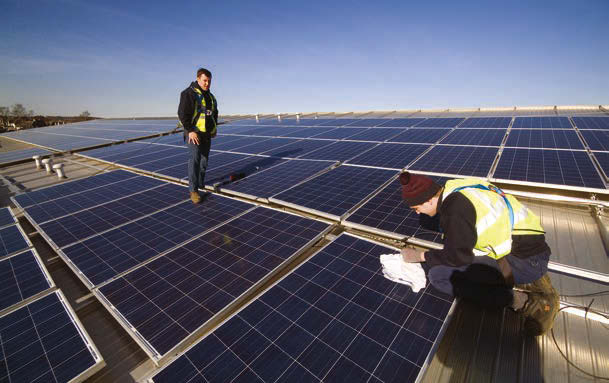FST JOURNAL
Electricity Supply
DOI: https://www.doi.org/10.53289/YNPX8111
A net-zero electricity system
Keith Bell

Professor Keith Bell FRSE CEng holds the Scottish Power Chair in Smart Grids at the University of Strathclyde. He joined the University in 2005 having previously been an electrical engineering researcher in Bath, Manchester and Naples, and a system development engineer with National Grid. He is a member of the UK’s Climate Change Committee, a co-Director of the UK Energy Research Centre and is involved in CIGRE, the International Council of Large Electric Systems. He is a Chartered Engineer and Fellow of the Royal Society of Edinburgh.
The electricity system is changing towards greater use of variable renewables – wind and solar as well as hydro. Wind and solar are connected to the network using power electronics, which are also used by subsea interconnectors between Britain and other countries. Sources of power connected in this way are termed ‘inverter-based’ resources.
These contrast with the traditional system based on the big thermal power stations of previous years, which created a great deal of heat to produce steam under high pressure to turn a turbine, which uses a synchronous generator to generate the electricity.
The challenge is to make efficient use of whatever low-carbon energy is available, when it is needed. There are a number of issues to be addressed in order to make that happen, not least an ability for the system to survive disturbances such as equipment faults or unexpected variations in weather. Look around the world and there is a national or regional blackout somewhere a number of times every year. We have to make sure that it does not happen here, although the possibility will always be there.
One particular event in August 2019 – triggered by a lightning strike on an overhead line, something that is not uncommon – led to disconnection of 1.1 million electricity customers across England and Wales. It had a particular impact in the South East of England, affecting trains that experienced a drop in the frequency of the electricity system to well below 50Hz which activated protection devices on the trains and made them stop. Technicians had to go out with laptops to restart them.
 Solar panels on roofs can help to manage variations in the system, but the system operator needs better monitoring of the connected supply.
Solar panels on roofs can help to manage variations in the system, but the system operator needs better monitoring of the connected supply.This particular event highlighted what happens if system frequency is not adequately managed and kept within acceptable operating limits. Equipment is designed only to operate within certain limits and will trip if these are breached. A cascade can then occur which results in a blackout. On this occasion, the lightning strike caused losses of generation that should not have happened but resulted in the fall of frequency. Other devices that should have responded to correct the fall in frequency failed to do so. If either of those errors had not occurred, 1.1 million customers would not have been disconnected.
Although many of the new technologies present new challenges to the system operator, the linking of a variety of sources of energy with power electronics and appropriate controls provides the opportunity to respond quickly and stabilise the system. The system operator is aware of this and is working on stimulating the market to provide the necessary services.
Synchronous generators create current, which is very dangerous when there is a short circuit on the network. However, they do enable automatic identification of where that fault lies, so that it can be isolated safely with the appropriate equipment before the whole system shuts down. Simply dispensing with all that synchronous plant might mean that faults are sometimes not identified and cleared in the right way: this could threaten the stability of the system. Again, there are things that can be done about it by changing the characteristics of the power electronic controls, or the algorithms in the protection equipment.
Local distributed generation, from solar panels on roofs to modestly sized Combined Heat & Power (CHP) units, can also help to manage variations in the system. However, to be an asset in this respect, the system operator needs a better understanding of that potential, including better monitoring of the connected supply, so that it can be integrated into the overall control capability for the grid.
The question of renewables
Nowadays, the cost of producing electricity from wind and solar is lower than from any other source in Britain. However, there are days when there is a lot of wind and sun, while on others there is not so much. At Strathclyde, we analysed all these variable renewables and how their availability coincides with demand for electricity. The difference between demand and the availability of variable renewables is the ‘residual demand’. Plotting this for each simulated hour of 2030 showed that there are challenges for the grid at both ends of the curve, when residual demand is high and when it is low.
When it is not windy and sunny, what else are can be used to meet the demand for electricity? There may also be times when there is a generation surplus, i.e. the residual demand is negative. We do not want to waste that really useful, low-carbon output. Storage could be a big part of the answer for both temporary shortage or surplus, whether it is stored hydrogen manufactured via low carbon means, compressed air, or something else. With a substantial increase in the number of electric vehicles with batteries plugged in at home every evening, perhaps we could use the stored energy in those batteries?
We need flexibility, of course, to meet changes of residual demand and fill any gaps. Flexibility means being able to adjust production or consumption quickly and at short notice. We need schedulabilty where we can schedule power to be produced at any given time on a given day in the future, including calm, dark days. And the system also needs persistence where increases in production or decreases in consumption can be sustained for a period of time, producing not just a certain instantaneous level of power but a significant amount of energy over a number of hours or days.
Network capacity
It is not possible to use all of the wind power produced north of the border within Scotland. Network constraints mean exports frequently have to be reduced, wind output turned down and something else – more expensive and usually fossil-fuel based – used in England. The network between Scotland and England has been upgraded in recent years but more capacity is needed. Installing more cables under the sea down the East Coast has been proposed but they have not been built yet. Further, it is not just the offshore links that are needed – more connections are needed onshore, too, in order to reach the places where electricity is used.
Power electronics is a very flexible technology, but much of it is currently designed in ignorance of what else is on the system. This pretends that the system is some sort of ideal network. In the real world, everything interacts with everything else. From time to time, they interact adversely and oscillations appear almost out of nowhere. These inverter-connected resources bring lots of opportunities but also challenges, including questions of commercial confidentiality for proprietary developments of their controls. We also need new tools and methods so that the system operator can ensure that all the parts of the system behave in a predictable and stable manner.
To sum up, there are fantastic opportunities, which we should be realising. Work is already underway on many of them and substantial progress is being made. The one overarching issue is to ensure enough investment in getting the right knowledge and skills within the sector to resolve these challenges.
Power electronics is a very flexible technology, but we pretend that the system is some sort of ideal network. In the real world everything interacts.
